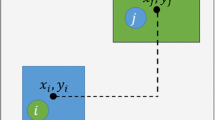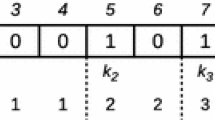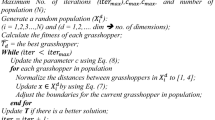Abstract
In both genetic algorithms (GAs) and simulated annealing (SA), solutions can be represented by gene representation. Mutation operator in GA and neighborhood function in SA are used to explore the solution space. They usually select genes for performing mutation. The rate of selection of genes can be called mutation rate. However, randomly selecting genes may not be the best way for both algorithms. This paper describes how to estimate the main effect in genes representation. The resulting estimates cannot only be used to understand the domination of gene representation, but also employed to fine-tune the mutation rate in both the mutation operator in the GA and the neighborhood function in the SA. It has been demonstrated the use of the proposed methods for solving uncapacitated facility location problems and discuss the examination of the proposed methods with some useful comparisons with both the latest developed GA and SA for solving this problem. For many well-known benchmark problems, the proposed methods yield better results in solution quality than the previously used methods.
Similar content being viewed by others
References
Aydin ME, Fogarty TC (2001) Simulated annealing with evolutionary process for job-shop scheduling problems. In: EUROGEN 2001 – Evolutionary methods for design, optimisation and control with applications to industrial problems, 19–21 September 2001, Athens, Greece
Aydin ME, Fogarty TC (2004) A distributed evolutionary simulated annealing for combinatorial optimisation problems. J Heuristics 10:3 (accepted)
Beasley JE (1996) Obtaining test problems via Internet. J Glob Optim 8:429–433, http://mscmga.ms.ic.ac.uk/info.html
Beasley JE, Chu PC (1994) A genetic algorithm for the set covering problem. Eur J Oper Res 94:392–404
Chan KY, Aydin ME, Fogarty TC (2003) An epistasis measure based on the analysis of variance for the real-coded representation in genetic algorithm. In: Proceedings of the IEEE international congress on evolutionary computation, pp. 297–304
Chan KY, Aydin ME, Fogarty TC (2004) Parameterisation of mutation in evolutionary algorithm using the estimated main effect of genes. In: Proceedings of the IEEE international congress on evolutionary computation
Chatterjee S, Carrera C, Lynch LA (1995) Genetic algorithms and traveling salesman problems. Eur J Oper Res 93:490–510
Chu PC, Beasley JE (1997) A genetic algorithm for the generalised assignment problem. Comput Oper Res 24(1):17–23
Daskin MS (1995) Network and discrete location: models, algorithms, and applications. Wiley, New York
Fogarty TC (1989) Varying the probability of mutation in the genetic algorithm. In: Proceedings of the 3rd international conferences on genetic algorithms pp 104–109
Kirkpatrick S, Gelatt CD, JR., Vecchi MP (1983) Optimization by simulated annealing. Sci 220:671–680
Kratica J, Tosic D, Filipovic V, Ljubic I (2001) Solving the simple plant location problem by genetic algorithm. RAIRO Oper Res 35:127–142
Lin CKY, Haley KB, Sparks C (1995) A comparative study of both standard and adaptive versions of threshold accepting and simulated annealing algorithms in three scheduling problems. Eur J Oper Res 83:330–346
Montgomery DC (1997) Design and analysis of experiments. Wiley, New York
Reeves C (1994) Genetic algorithms and neighbourhood search. In: Evolutionary computing: AISB workshop, pp 115–130
Reeves C (1997) Genetic algorithms for operations researcher. Informs J Comput 9(3):231–250
Ruiz-Torres AJ, Enscore EE, Barton RR (1997) Simulated annealing heuristics for the average flow-time and the number of tardy jobs bi-criteria identical parallel machine problem. Comput Ind Eng 33(1–2):257–260
Syswerda G (1989) Uniform crossover in genetic algorithms. In: Proceeding of the 3rd international conference on genetic algorithms, pp 2–9
Szu H, Hartley R (1987) Nonconvex optimization by fast simulated annealing. Proc IEEE 75(11):1538–1540
Vaessens RJM, Aarts EHL, Lenstra JK (1992) A local search template. In: Proceedings of parallel problem-solving from nature 2. pp 65–74
Wilson JM (1997) A genetic algorithm for the generalised assignment problem. J Oper Res Soc 48:804–809
Yao X (1991) Simulated annealing with extended neighbourhood. Int J Comput Math 40:169–189
Yao X (1993) Comparison of different neighbourhood sizes in simulated annealing. In: Proceedings of 4th Australian conference on neural networks, pp 216–219
Yigit V, Aydin ME, Turkbey O (2004) Evolutionary simulated annealing algorithms for uncapacitated facility location problems. In: Proceedings of adaptive computing in design and manufacture, pp 20–22
Author information
Authors and Affiliations
Corresponding author
Rights and permissions
About this article
Cite this article
Chan, K.Y., Aydin, M.E. & Fogarty, T.C. Main Effect Fine-tuning of the Mutation Operator and the Neighbourhood Function for Uncapacitated Facility Location Problems. Soft Comput 10, 1075–1090 (2006). https://doi.org/10.1007/s00500-005-0044-4
Published:
Issue Date:
DOI: https://doi.org/10.1007/s00500-005-0044-4




